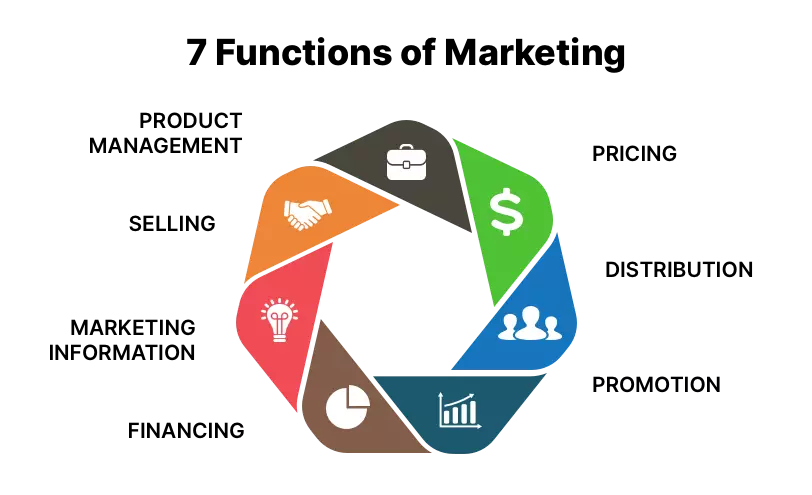Ever felt like you were shouting into the void when it came to marketing? You’re not alone here.
So many entrepreneurs and small business owners start marketing with the same thought:
“I just need to sell more!”
But there’s a whole world of marketing functions beyond just running ads.
Think of it as a multi-faceted approach that helps you reach your target customer, build a strong brand, and ultimately, dominate your industry. Ready to unlock its full potential? Let’s dive into that.

1. Promotion: Create a Brand Image That Rocks
Building a strong brand image is like building a reputation—it’s about who you are, what you stand for, and how you want to be perceived.
- What’s Your Story? Start by crafting your brand narrative: What’s your unique selling proposition? What makes you different? For more on crafting a unique selling proposition, check out this article: What is a Unique Selling Proposition? Examples & Mistakes.
- Know Your Audience: Don’t try to appeal to everyone. Who is your ideal customer? What are their needs, values, and passions? For deeper insights into understanding your perfect customers, read this article: Target Market Research – How to Understand Your Perfect Customers.
- Stay Authentic: Don’t try to be someone you’re not. Be true to your core values and let your personality shine through.
- Engage and Connect: Make your customers feel like part of your guild. Respond to their comments, ask them questions, and build genuine relationships. Think of your business as a conversation between you and your clients. Marketing is often the line of communication between the two. Just like any conversation, it can’t only be about you and your products. You need to establish a dialogue, care about their wants and needs, and listen to what they have to say, instead of just chasing after their money.
- Stay Relevant: Keep your brand fresh and exciting by adapting to current trends and embracing change. Even giants like Coca-Cola and Apple have to constantly evolve to stay top-of-mind. If you’re stuck in the past, you’ll be left behind in the dust.
- Build Trust: Your reputation is everything. Ensure your brand is known for its quality, reliability, and customer service. This shows that you value and appreciate your customers, enhancing your brand’s image. Other people will see this and know they will receive similar treatment if they’re ever in the same position. Nobody wants to be a one-night stand with their customers—build a lasting relationship!
- Motivate Your Team: Marketing is about more than just customers; it also plays a crucial role in building a strong internal brand. When your staff sees how their work is making customers happy, they’re more likely to feel motivated and appreciated. They’re also more likely to be more invested in your marketing efforts, leading to a positive upward spiral of success.
- Align Your Direction: Effective marketing helps you and your employees determine the company’s direction. The data generated will ensure you’re as well-informed as possible to make the best decisions for your business.
2. Marketing Information Management: Unlock the Secrets of Your Audience
To build a successful marketing strategy, you need to have a deep understanding of your market.
- Analyze the Data: Use analytics tools to track your digital marketing campaigns, understand customer demographics, and see what’s working and what’s not. For small and medium businesses, analytics can reveal your average customer acquisition cost (CAC) and help identify which customer segments convert better. This information is crucial for refining your product and services to better meet customer needs.
- Know Your Ideal Customer: Who is your ideal customer? What are their needs, wants, and pain points? Use this information to tailor your products and services to them. Get to know your customers better than they know themselves—that’s the key to success.
- Watch Your Competitors: Keep an eye on what your rivals are doing and learn from their successes and failures. For deeper insights into competitor analysis, check out this article: Competitor Analysis – 4 Types of Competitors in the Market Environment.
- Stay Ahead of the Curve: Monitor market trends and anticipate future changes. Social media and surveys are great tools to gather this information. For example, J.Crew collects customers’ zip codes to understand their distribution and focus on areas needing more attention. Always be learning, always be adapting, and always be one step ahead.
3. Pricing: Find the Sweet Spot
How much should you charge? This is a big question, and the answer isn’t always simple.
- Competitive Analysis: Compare your prices to your competitors. Are you offering a better value?
- Value for Money: Are you going for a low price point or a premium price? Consider your target audience and your brand image. For example, in fast fashion, being the cheapest may be beneficial, while luxury items might be priced higher to emphasize exclusivity.
- Market Research: Use the insights you’ve gathered about your customers and the market to make smart pricing decisions. If you need a primer on pricing strategies, check out this article: Overview of Pricing Strategies – Finding the right pricing strategy for your products.
4. Product Management: Keep Your Products Awesome
Your product needs to be the best it can be, and that means constantly improving and evolving.
- Customer Feedback: Listen to your customers! What do they like? What could be better?
- Product Marketing: Use your marketing expertise to research customer needs and identify opportunities for new product development. Coca-Cola, for example, has been changing their bottle design and flavor for decades to stay relevant. Since 1889, they changed how the bottle looks seven times. The flavor also hasn’t stayed constant, evolving seven times since the original 1886 formula. It’s not about being perfect—it’s about constantly evolving and improving.
- Stay on Top of Trends: What’s new and exciting in your industry? How can you adapt your product to meet changing needs? For a deeper dive into product management, check out this article: What is a Product and How To Build An Irresistible One.
5. Selling: Close More Deals and Build Lasting Relationships
Marketing sets the stage for sales, but selling is all about closing the deal.
- Build Trust: Create a strong brand image and build a connection with your customers. Show them you’re on their side.
- Provide Value: Offer helpful content and resources that demonstrate your expertise. Effective marketing, including blogs and other content, can significantly boost brand visibility and customer traffic. Did you know that businesses using blogs receive twice as much email traffic as those that don’t?
- Make It Easy: Make it easy for customers to find, buy, and use your products or services.
- Expand Your Sales Channels: Explore different ways to reach your customers, both online and offline.
6. Distribution: Get Your Products in Front of the Right People
How do you get your products into the hands of your customers? This is where distribution comes in.
- Know Your Channels: Are you selling online, in physical stores, or both? Which distribution channels are best for your target market?
- Optimize Your Distribution: Make sure your distribution strategy is efficient and cost-effective.
- Adapt and Grow: As your business grows, your distribution strategy will likely need to evolve as well. If you’re a high-end luxury brand, you wouldn’t distribute through Target. Your marketing team might identify that most of your sales come from online stores and advise you to shift focus online. Peet’s Coffee, for example, rotates their products weekly on store shelves to maintain freshness and reinforce their premium image. Over 700 employees personally rotate the products each week, ensuring the coffee stays fresh.
7. Financing: Secure the Funds You Need
You can’t launch and grow your business without a solid financial plan.
- Budgeting: Create a realistic budget for your marketing efforts.
- Funding Options: Explore different ways to finance your marketing, including bank loans, crowdfunding, or venture capital.
- Return on Investment: Track your marketing investments to see what’s generating the most return. For instance, Bodyform’s “Womb Stories” campaign highlighted a rarely discussed issue, greatly boosting their brand image and sales. They received 1.1 million views and 54.6 thousand likes on Instagram, as well as 1.2 million retweets and 3.4 thousand likes on Twitter. Do you think their sales went up or down? For more on how PR can be a powerful marketing tool, check out this article:
PR as a Marketing Tool: Step-By-Step Guide to Making Your Brand Stand Out.
Takeaways: Marketing is a Powerful Tool
Marketing is not only about advertising. When you combine all of its functions, you’ll be able to:
- Build a strong brand that resonates with your customers.
- Understand your target market and their needs.
- Optimize your product and services.
- Drive sales and achieve your business goals.












